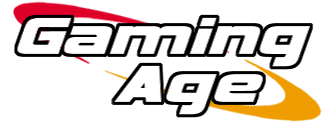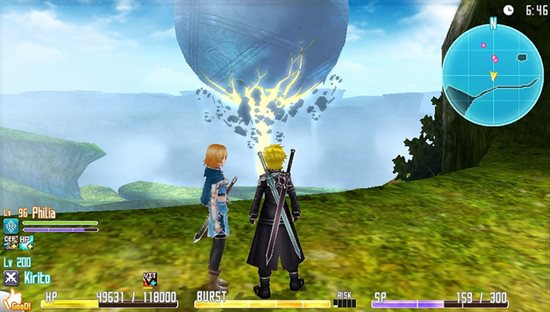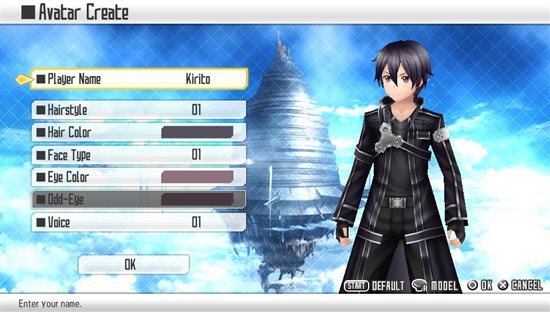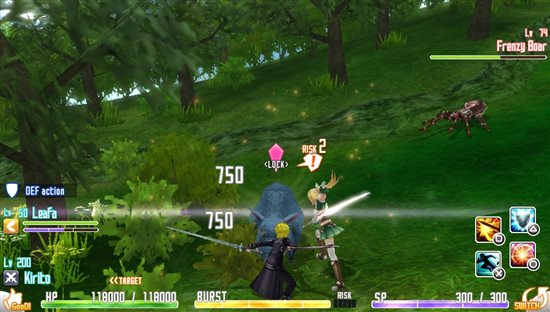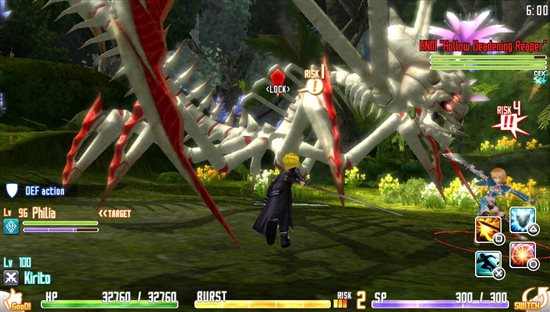Publisher: Bandai Namco
Developer: Bandai Namco
Medium: Digital
Players: 1-4
Online: No
ESRB: T
I like Sword Art Online: Hollow Fragment. I really do. It’s a fun, deep game, and I enjoyed my time with it.
I’m saying this up front because, for a game that I liked, I’m having a really easy time thinking of all the things I didn’t like about it, and a much harder time saying what, exactly, I liked so much.
Take, for example, the whole way SAO:HF presents information to you, the player. Or, to put it more bluntly: this game features lots and lots of massive infodumps. Head into a battle, and you have to click through pages and pages of explanation on what each piece of on-screen information means. Talk to a random character, and you’re liable to trigger ten minutes of unskippable dialogue. Walk into a new area, and you trigger an endless cutscene. Throughout Sword Art Online, the developers regularly commit the sin of telling rather than showing, and unless you’re already deeply invested in the game’s characters and their relationships because of prexisting anime fandom, it’s hard to keep it all straight.
In fairness, of course, the infodumps aren’t wholly useless. If, like me, you’re going into Sword Art Online: Hollow Fragment without any prior knowledge of the series, there’s definitely value in getting an overview of the basic storyline. Similarly, there’s a whole lot going on here, so there’s certainly an argument to be made that it’s better to know too much about a game’s mechanics than too little. I, personally, wouldn’t make that argument, but at least I sort of understand where it’s all coming from.
It’s a lot harder to sit through those interminable dialogue sequences though — and not just because they’re regularly provided with little indication of who the other people are and why you’re talking to them for so long. No, what makes them even harder to take is that they don’t look so great. That’s not to say they look bad; indeed, SAO:HF’s dialogue scenes look like virtually every other JRPG’s dialogue — which is to say, you get people sliding on and off the screen as they say their lines, and you trigger each new line by pressing X (or, in this case, O, since the Japanese controls were kept intact). That, by itself, isn’t the worst thing; it makes SAO seem like (insert name of every other recent Vita JRPG here).
Rather, what makes those static dialogues hard to take is that the animated cutscenes look so fantastic. When the action switches over to straight-up animation, it feels like you’re watching a TV show (or, presumably, the cartoon series on which the show is based). It’s a lot easier to get drawn in when you’re watching actions unfold, rather than when you’re constantly being told to press a button to advance to the next line. I get that animating a whole game’s worth of cutscenes would call for a budget that’s probably unrealistic for a Vita game, but at the same time, those teases of what could’ve been are so tantalizing. For that matter, even the non-cutscenes look pretty great — as you’re exploring the world of Sword Art Online, you’re regularly shown a place that’s much more richly fleshed out than most other Vita games of this ilk.
And on the topic of exploration, there’s another major flaw: the camera controls in this game are occasionally horrendous. While it’s easy enough to correct a weird perspective when you’re running across a field, it’s pretty much impossible to do that in the middle of a battle. Throughout my time in Sword Art Online, I would regularly find my onscreen character stuck on the other side of a charging enemy. Or, worse, I’d find that the camera had suddenly gotten stuck in a fixed position which gave me no context as to where my character was. Needless to say, it’s difficult to fully appreciate a game when you can’t see yourself, or your enemies, or pretty much anything of use to you as a player.
Yet, despite all my problems with the game, I still really liked it. The combat is relatively simple and straightforward; where most JRPGs stick to the tried-and-true formula of team- and turn-based combat on an isometric grid, Sword Art Online: Hollow Fragment takes a hackier and slashier approach. You still have the option of fighting monsters with a party of teammates, but you get to move a little more freely around wide-open spaces, attacking whatever enemies get in your way in real-time combat.
Speaking of moving around wide-open spaces, that’s another good thing about Sword Art Online: this is a big, expansive game, both in terms of its physical space (it’s designed to be a faux-MMO, and it feels like that) and in terms of the story. Presumably because the game is based on a property with its own, fully-developed mythology, this game has a lot going on. There’s literally a universe to explore, and even if the exposition may occasionally go a little overboard, it’s still great (if a little daunting) to have so much to do.
And that, in a nutshell, is what makes Sword Art Online: Hollow Fragment so compelling. It may have more than its fair share of flaws, but a lot of that’s because it tries to do so much. This is a big, ambitious game, and like any big, ambitious game, there’s some stuff that goes wrong, but a lot more that goes right. And with all that right stuff…well, that’s what makes the game so worth playing.
